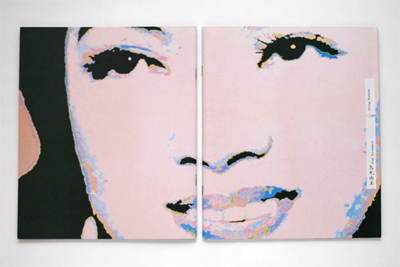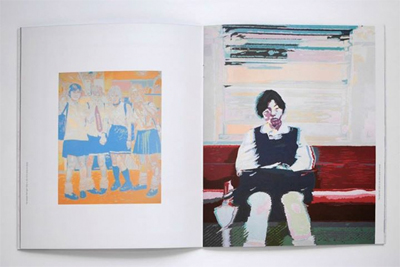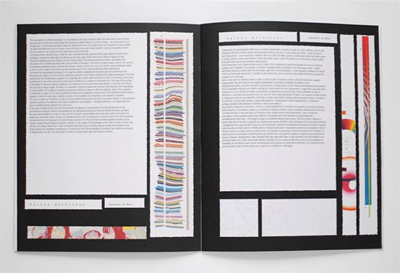From the catalog of the personal exhibition "Facing Histories"
at Marcel Scheiner Gallery, South Carolina, USA 2002
- Interview to Yumi Karasumaru
by Emanuela De Cecco (art critic)

How was the idea of coming to live in Italy born?
I was looking for a way to look at my country from far away. Moving to Italy has allowed me to confront myself to the differences in culture and mentality…
It's not by chance that your personal story interweaved with your country's biography has progressively become the centre of your work…
If I hadn't left I think I wouldn't have embarked on the same type of job, because I wouldn't have been able to develop the same kind of glance towards history, culture, tradition and towards what's happening in Japan today.
Watching a situation from far away allows you to focus on the aspects that do not seem as clear as from close up. I started working on the images of my family and progressively I started thinking about my country's history, the Second World War and the atomic bomb.
How has your relationship with Japan changed in all of these years?
As time goes by I feel always more Japanese. In the beginning I had difficulties in learning the language and in interacting with a different way of thinking compared to mine. I have changed a lot in twelve years and now the opposite is happening to me. When I go back home it's hard to get settled down again, maybe my way of behaving has become strange for them.
Is it hard to keep the attention alive on your country while you see it changing from far away?
It's worrying because the climate is changing; also under the economic point of view the situation is not easy. From the post Second World War period up to today, Japan has been a rich country, super modern and with a charming tradition, but today too many people are stressed, many of them work up to thirteen hours a day…Many problems can be written inside this frame…I ask myself how can you find space for thinking if you are forced to hurry…Regarding this, last summer I read a book on the atomic bomb. Five years after the explosion, the mayor of Hiroshima decided to realize a book on the survivors' testimonies. About 160 letters were gathered and about 30 were chosen for the book. Due to the dramatic power of the material and to the control of the local government (which was controlled by the American one), the book was published in the mid sixties (twenty years after the explosion). I found it disturbing, but also beautiful because you don't perceive hatred in the words, but only the tale of what happened, the desire for peace and the hope that nobody else lives a similar experience. They are the voices of normal people, elders and children. I think it's a book we should all read…
Starting from the images of the explosion you have realized a series of paintings…
Yes, as usual I have started from the photos of the bombs and of the also well known ones of the injured. In '99 I displayed these works at the Hiroshima Prefectural Art Museum during the days of the anniversary.
How was this work welcomed there?
It was interesting because people who had personally lived that experience came to see the exhibition and, in front of the paintings, they told me what they were feeling…I used some of these tales in one of my last performances…They are difficult to tell for the survivors, it was such a strong experience that it took decades to do it.
The choice of the colors?
I wanted them to be very vivid, pleasant, and ironically caramel colored. I didn't want it to be a realistic representation, but terrible and at the same time beautiful, aspects that can tragically live together. Some of the survivors told me that the colors of the bomb's flash are beautiful and I wanted to color these tragic images. I think it's important to confront ourselves to the context in which we display our work: Japan, Italy and now the United States…
I'm interested in seeing the reactions of the public, I can't foresee them. I think it won't be easy because there's a referral to a historical responsibility and because there's a tragically indirect relation to the attacks of last September…
Andy Warhol showed electric chairs and these images struck hearts at that time, but I think that recent history needs further consideration…a redefinition of the boundaries of what can be represented and of what is obscene is necessary, we must rethink of the relation between reality and representation…But talking about the public's reaction, how did it go in Italy?
The Italians have lived the story of the atomic bomb from far away, so the relations are much separated.
And the paintings you have realized starting from your family photos?
I think the family, present or absent, is the nucleus of the world; it represents everybody's emotional base. I started working starting from my family photos, from the ones of the past to others of when I was little…
Lately you have started to look at what's happening today, to today's teenagers…
About a year ago I started working on a new series of paintings…teenagers compared to our generation seem to belong to a new race, they have different objects, the most of them are basically interested in having designer bags and clothes, some girls become prostitutes to buy them and they justify themselves saying that they are helping – on payment – men that have problems…
Someone thinks that the dissolution of identity can constitute a characteristic mark of the contemporary world. I wonder if it's easier to cross the world with a light bag or to carry along the weight of history and tradition that give assurance but that influence behavior…
It's hard for me to say, I don't think there is a better or worse position…both excess and lack of identity produce uneasiness. In this sense the Japanese mentality plays an important role: we always move in a group, like soldiers. The government commands and everybody carries out the orders. The most of the people are perfect in executing, but they have a crisis when they have to think of what to do. In every village there used to be a group and all the decisions were taken after a collective consultation. Today this bond is weaker and only the worst part of the idea of group has remained.
The Japanese are kind but it's difficult to really make friends with them, living spaces are tight and an environment in which you can welcome guests like in traditional houses is not foreseen. Now, when you close the door, the world remains outside…

Intervista a Yumi Karasumaru - di Emanuela De Cecco (critico d'arte)
Com'è nata l'idea di venire a vivere in Italia?
Ero in cerca di un modo per vedere il mio Paese da lontano. Trasferirmi in Italia mi ha permesso di confrontarmi con le differenze di cultura e di mentalità…
Non a caso la trama della tua storia personale intessuta con la biografia del tuo Paese è progressivamente diventata il centro del tuo lavoro…
Se non fossi partita credo che non avrei intrapreso lo stesso tipo di lavoro perché non avrei potuto sviluppare lo stesso tipo di sguardo nei confronti della storia, della cultura, della tradizione, di quello che accade nel Giappone oggi. Vedere una situazione da lontano consente di metterne a fuoco degli aspetti che da vicino non appaiono con la stessa chiarezza. Ho iniziato a lavorare sulle immagini della mia famiglia e, progressivamente, ho iniziato a ripensare alla storia del mio Paese, alla seconda guerra mondiale, alla bomba atomica.
Come è cambiato in tutti questi anni il rapporto con il Giappone?
Via via che passa il tempo mi sento più giapponese. All'inizio ho fatto fatica ad imparare la lingua e ad interagire con un modo di pensare diverso dal mio. In dodici anni sono molto cambiata e adesso accade il contrario. Quando torno a casa fatico ad ambientarmi, forse il mio modo di fare per loro è diventato strano.
E' difficile mantenere viva l'attenzione verso il tuo paese che vedi cambiare da lontano?
E' preoccupante perché il clima sta peggiorando, anche dal punto di vista economico la situazione non è facile. A partire dal Secondo Dopoguerra fino ad ora il Giappone è stato un paese ricco, supermoderno e con una tradizione affascinante ma oggi troppe persone vivono sotto stress, molti lavorano fino a 13 ore al giorno… E' in questa cornice che s'inscrivono moltissimi problemi…. Mi chiedo come si possa trovare lo spazio per riflettere se si è costretti ad andare sempre così di fretta… A proposito la scorsa estate ho letto un libro sulla bomba atomica. Cinque anni dopo lo scoppio il sindaco di Hiroshima decise di realizzare un libro con le testimonianze dei sopravvissuti. Sono state raccolte circa 160 lettere, una trentina sono state scelte per il libro. Vista la drammaticità del materiale e visto il controllo del governo locale a sua volta controllato dal governo americano, il libro è stato pubblicato solo a metà degli anni Sessanta (venti anni dopo lo scoppio). Io l'ho trovato sconvolgente ma anche bellissimo poiché dalle parole non si percepisce odio ma il racconto di quanto è avvenuto e il desiderio di pace, il desiderio che nessun altro possa vivere un'esperienza analoga. Sono voci di persone normali, vecchi e bambini, credo che sia un libro che dovremmo leggere tutti…
A partire dalle immagini dell'esplosione hai realizzato una serie di quadri…
Sì, come sempre sono partita dalle fotografie, sia della bomba, sia di quelle altrettanto note dei feriti. Nel '99 ho esposto questi lavori all'Hiroshima Prefectural Art Museum nei giorni dell'anniversario.
Com'è stato accolto lì questo lavoro?
E' stato interessante perché sono venute a vedere la mostra persone che avevano vissuto in prima persona quell'esperienza e, davanti ai quadri, mi hanno raccontato cosa avevano provato… In una delle mie ultime performance ho utilizzato alcuni di questi racconti… Per i sopravvissuti è difficile raccontare, è stata un'esperienza così forte che ci sono voluti decenni per farlo.
La scelta dei colori?
Volevo che fossero molto vivaci, gradevoli, ironicamente caramellati. Non volevo che fosse una rappresentazione realistica ma terribile e allo stesso tempo bellissima, aspetti che tragicamente possono convivere. Qualcuno dei sopravvissuti mi diceva che i colori del flash della bomba sono bellissimi, io volevo colorare queste immagini tragiche.
Credo sia importante confrontarsi con il contesto in cui si espone il proprio: il Giappone, l'Italia, adesso gli Stati Uniti…
M'interessa vedere quali saranno le reazioni del pubblico, non posso prevederle. Credo che non sarà facile sia perché c'è un riferimento ad una responsabilità storica, sia perché c'è una relazione tragicamente indiretta con gli attentati di settembre dell'anno scorso…
Andy Warhol mostrava le sedie elettriche e queste immagini colpivano al cuore l'immaginario corrente, credo però che la storia recente richieda un'ulteriore riflessione… urge una ridefinizione dei confini di ciò che è rappresentabile e ciò che è osceno, urge ripensare le relazioni tra la realtà e la rappresentazione… Ma tornando alla reazione del pubblico com'è andata in Italia?
Gli italiani hanno vissuto la storia della bomba atomica da lontano, dunque le reazioni sono molto distaccate.
E i quadri che hai realizzato a partire dalle foto di famiglia?
Penso che la famiglia sia il nucleo del mondo in quanto, presente o assente che sia, rappresenta la base affettiva di chiunque. Io ho cominciato a lavorare partendo dalle mie fotografie di famiglia, da quelle del passato ad altre di quando ero piccola…
Ultimamente hai iniziato a guardare quello che succede adesso, gli adolescenti di oggi…
Da circa un anno ho cominciato una nuova serie di quadri… i teen ager rispetto alla nostra generazione sembrano appartenere a una nuova razza, hanno oggetti diversi, la gran parte sono interessati più di ogni altra cosa ad avere borse e vestiti firmati, alcune ragazzine si prostituiscono per comprarseli e si giustificano dicendo che stanno aiutando – a pagamento - uomini che hanno problemi…
C'è chi pensa che la dissoluzione dell'identità possa costituire un tratto caratteristico del mondo contemporaneo. Mi chiedo se sia più semplice attraversare il mondo con il bagaglio leggero o portare con sé il peso della storia e delle tradizioni che danno sicurezza ma condizionano i comportamenti…
Mi è difficile dirlo, non credo che in assoluto ci sia una posizione migliore o una peggiore… sia l'eccesso di identità che la mancanza producono disagio. In questo senso la mentalità giapponese gioca un ruolo importante: noi ci muoviamo sempre in gruppo, come i militari. Il governo comanda e tutti eseguono, la maggior parte delle persone è perfetta nell'esecuzione ma va in crisi quando deve pensare cosa fare. In ogni villaggio c'era un gruppo e tutte le decisioni erano prese dopo un consulto collettivo. Oggi questo legame si è allentato ed è rimasta la parte peggiore dell'idea di gruppo.
Oltretutto i giapponesi sono gentili ma è difficile fare amicizia davvero, gli spazi dove si vive sono ristretti, non è previsto un ambiente dove accogliere gli ospiti come nelle case tradizionali. Adesso, quando si chiude la porta di casa, il mondo resta fuori…
